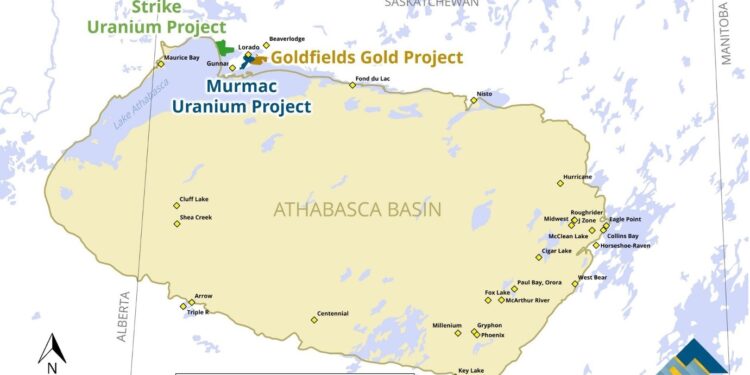Fortune Bay Corp. (TSXV: FOR) has identified its initial drill targets for its 100% owned Murmac Uranium Project, located in northern Saskatchewan, Canada.
Highlights:
- Nineteen initial drill targets have been identified following completion of airborne electromagnetic (EM) and ground gravity surveying.
- The targets represent favourable geophysical and geological features typically associated with high-grade basement-hosted uranium deposits related to the Athabasca Basin. Targets include discrete gravity lows located along prominent EM conductors proximal to numerous radioactive and uranium surface showings and/or favourable structural features.
- Drilling is expected to commence in the coming days with approximately 2,500 meters planned in eight to ten drill holes. The programme is expected to be results-driven and may be modified based on results from drilling.
“We are pleased to announce an initial set of drill targets for Murmac which have the potential to yield a discovery of high-grade, basement-hosted uranium mineralisation related to the Athabasca Basin,” CEO, Dale Verran, said.
“The maiden drilling programme, scheduled to commence shortly, is planned to test an initial eight to ten targets along three prospective corridors. We look forward to reporting drill results for Murmac, in addition to results from the ongoing drilling at the Strike Uranium Project.”
Murmac Drill Targeting
- Targeting at Murmac has encompassed detailed review of historical data which have been integrated with newly acquired datasets, which include a VTEM (Versatile Time Domain Electromagnetic) survey completed in April 2022 and a ground gravity survey completed in June 2022. Targeting is currently focused exclusively in areas where gravity survey data have been acquired. The company plans to carry out additional gravity surveying to continue coverage over the conductive units to the northeast and northwest.
- Multiple linear conductor traces spanning the entire length of the project area (approximately 12 kilometres) have been identified from the VTEM survey, and three of these conductor packages (named the Pitchvein, Armbruster and Howland Corridors) have been prioritised. Targets along these conductors were selected based on the nature and amplitude of the electromagnetic anomaly, gravity features, topography and surface exposure, magnetic features, structural setting and historical scintillometer survey and geochemical sampling results.
- The southern portions of the Armbruster and Howland Corridors have been subjected to historical surface prospecting and geophysics, but very little exploratory drilling. Only seven holes have been drilled on the southernmost seven kilometres of each of these two corridors. This area is characterised by more extensive overburden cover where historical surface prospecting efforts would have had limited value.
- The Pitchvein Corridor was first explored in the 1950’s by Pitchvein Mines, who carried out surface prospecting and diamond core drilling. Exploration continued in the period 1978 to 1982 by SMDC who carried out further ground geophysics and drilling, with assessment reports documenting intersections including 1.01% U3O8 over 2.0 metres (56.0 to 58.0 metres in drill hole CKI-9) and 2.19% U3O8 over 0.5 metres (68.0 to 68.5 metres in drill hole CKI-10) in quartzite horizons within graphitic sediments. All the historical exploration and drill data have been captured by Fortune Bay and have been used to support prioritization of three drill targets on the southern portion of this corridor.
Drilling Programme and Operational Details
Drilling of the initial target areas is expected to commence in the coming days following completion of drilling at the Strike Uranium Project. The Company has the required permits for the planned exploration activities.
For further information please visit: http://www.fortunebaycorp.com/












